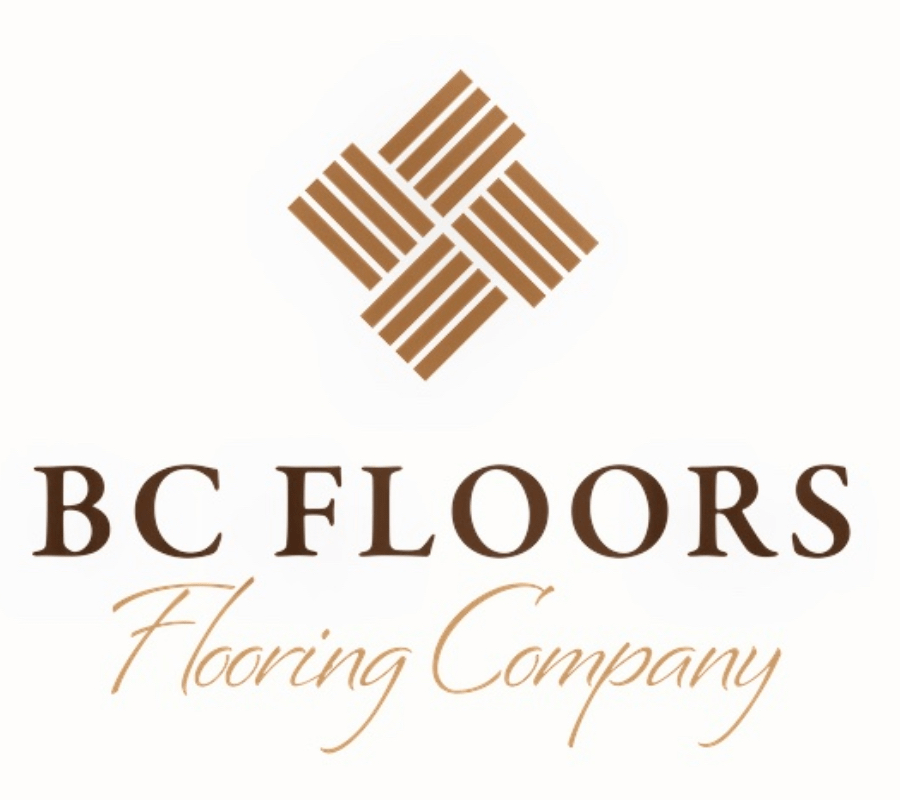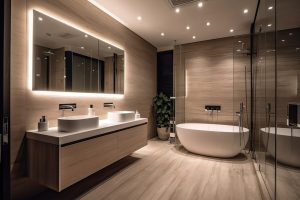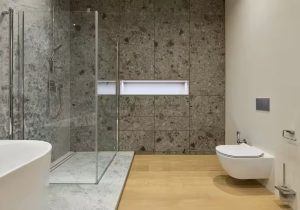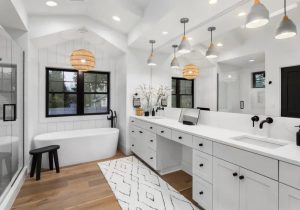Bathroom flooring choices in Vancouver face unique challenges due to the Pacific Northwest’s naturally humid climate and frequent rainfall. Traditional flooring materials often struggle to maintain their integrity in these moisture-rich environments, leading homeowners to seek innovative solutions that combine beauty with performance. Engineered hardwood flooring has emerged as a sophisticated option that addresses Vancouver’s specific climate concerns while delivering the warmth and elegance of natural wood. This flooring technology offers a practical way to bring hardwood’s timeless appeal into their bathroom spaces without compromising on durability or moisture resistance.
The Benefits of Engineered Hardwood Flooring in Bathrooms
Engineered hardwood flooring has gained significant popularity among Vancouver homeowners seeking to combine natural wood beauty with practical performance in bathroom environments. The unique layered construction of engineered hardwood addresses many concerns traditionally associated with wood flooring in moisture-prone areas. Vancouver’s coastal climate presents specific challenges for flooring materials, making the moisture resistance of engineered hardwood particularly valuable for local homeowners.
Understanding Engineered Hardwood Flooring
— Construction and Design
Engineered hardwood flooring represents a sophisticated flooring solution that combines the natural beauty of real wood with enhanced structural stability. This innovative flooring consists of multiple layers, with a top layer of genuine hardwood veneer bonded to several layers of high-quality plywood or fiberboard substrate. The cross-grain construction creates a dimensionally stable product that resists expansion and contraction significantly better than solid hardwood.
—Manufacturing Process and Performance
The manufacturing process involves precision engineering where each layer is carefully oriented to counteract the natural movement of wood fibers. This multi-layered approach results in a flooring product that maintains the authentic appearance and texture of solid wood while offering superior performance characteristics. The top wear layer typically ranges from 2mm to 6mm in thickness, providing ample material for refinishing throughout the floor’s lifespan.
— Modern Technological Advances
Modern engineered hardwood incorporates advanced adhesive technologies and moisture-resistant core materials. Many manufacturers now utilize waterproof cores made from stone plastic composite or high-density fiberboard treated with moisture-blocking agents. These technological advances have transformed engineered hardwood from a primarily dry-area flooring option into a viable choice for moisture-prone environments.
Why Choose Engineered Hardwood for Bathrooms?
— Vancouver’s Unique Climate Considerations
Vancouver’s coastal climate presents specific challenges for bathroom flooring, with outdoor humidity levels often exceeding 70% during the rainy season and dropping significantly during drier months. These dramatic humidity fluctuations can wreak havoc on traditional flooring materials, making moisture-resistant options particularly valuable for local homeowners. Engineered hardwood’s superior dimensional stability makes it well-suited to handle Vancouver’s variable climate conditions.
— Performance Under Challenging Conditions
Bathrooms present unique challenges for flooring materials due to fluctuating humidity levels, temperature variations, and occasional water exposure. Traditional flooring options often struggle to maintain their integrity and appearance under these demanding conditions. Engineered hardwood addresses these challenges through its inherent structural design and modern protective treatments.
The moisture resistance of engineered hardwood stems from its layered construction and specialized core materials. Unlike solid hardwood, which can cup, crown, or gap when exposed to moisture, engineered hardwood maintains its dimensional stability. The cross-grain layering system distributes stress evenly throughout the plank, preventing the warping and splitting commonly associated with moisture exposure.
Temperature fluctuations in bathrooms, particularly near heating vents or radiant floor systems, can cause traditional materials to expand and contract dramatically. Engineered hardwood’s multi-layer construction accommodates these thermal movements without compromising the floor’s structural integrity or visual appeal.
Advantages of Engineered Hardwood Flooring in Bathrooms
— Moisture Resistance and Durability
Engineered hardwood flooring offers exceptional moisture resistance through its engineered core and protective finishes. Many products feature waterproof cores that prevent moisture penetration, while advanced polyurethane or aluminum oxide finishes create a protective barrier on the surface. These features work together to create a flooring system that can withstand the humid conditions typical of bathroom environments.
The installation versatility of engineered hardwood proves particularly beneficial in bathroom applications. Most engineered hardwood products can be installed as floating floors, eliminating the need for nails or staples that could create moisture entry points. This installation method also allows for easy removal and replacement if necessary, providing long-term flexibility for bathroom renovations.
— Comfort and Aesthetic Appeal
Comfort underfoot represents another significant advantage of engineered hardwood in bathrooms. The natural wood surface provides warmth and cushioning that ceramic or stone floors cannot match. This comfort factor becomes especially important in bathrooms where people often walk barefoot. The natural insulating properties of wood help maintain comfortable surface temperatures even during cooler months.
The aesthetic appeal of engineered hardwood brings warmth and natural beauty to bathroom spaces. Wood’s organic patterns and textures create visual interest and can make small bathroom spaces appear larger and more inviting. The wide variety of wood species, stain colors, and plank sizes available in engineered hardwood allows for extensive design customization to complement any bathroom style.
— Long-term Performance
Durability represents a key strength of engineered hardwood flooring. High-quality products can withstand decades of use while maintaining their appearance. The protective finish resists scratches, stains, and wear, while the solid wood veneer can be refinished multiple times to restore its original beauty. This longevity makes engineered hardwood a sound investment for bathroom flooring.
Comparing Engineered Hardwood to Traditional Hardwood
— Structural Differences and Stability
Traditional solid hardwood flooring consists of single pieces of wood cut from tree trunks, making it susceptible to moisture-related movement and damage. Solid hardwood expands and contracts significantly with humidity changes, leading to gaps, cupping, and other structural issues in bathroom environments. The grain direction runs consistently throughout the entire thickness, creating weak points where moisture can cause splitting or warping.
Engineered hardwood’s layered construction provides superior dimensional stability through its cross-grain design. Each layer’s grain runs perpendicular to adjacent layers, creating a balanced structure that resists movement in all directions. This engineering approach allows the flooring to maintain its flat, stable surface even when exposed to moisture and temperature fluctuations common in bathrooms.
— Installation Methods and Maintenance
The installation requirements differ significantly between these two options. Solid hardwood typically requires nail-down installation over a wooden subfloor, creating numerous penetration points where moisture could enter. Engineered hardwood offers multiple installation methods, including floating installations that eliminate subfloor penetrations and reduce moisture vulnerability.
Refinishing capabilities vary between solid and engineered hardwood. You can sand and refinish solid hardwood numerous times because it maintains a consistent thickness throughout. You can also refinish engineered hardwood, although the number of times depends on the thickness of its wear layer. Most engineered hardwood products with wear layers of 3mm or more allow for two to three refinishing cycles, offering decades of renewed beauty.
Installation Process of Engineered Hardwood Flooring
— Subfloor Preparation and Acclimation
Proper subfloor preparation forms the foundation of successful engineered hardwood installation in bathrooms. The subfloor must be level, dry, and structurally sound. Any existing flooring should be removed, and the subfloor should be inspected for moisture damage, squeaks, or structural deficiencies. Installing a moisture barrier becomes crucial in bathroom applications to prevent moisture migration from below.
Acclimation of the engineered hardwood planks ensures optimal performance after installation. The flooring should be stored in the bathroom environment for 48 to 72 hours before installation, allowing the material to adjust to the room’s temperature and humidity conditions. This acclimation period prevents post-installation movement and ensures proper fit and finish.
— Floating Floor Installation and Sealing
The floating floor installation method proves ideal for bathroom applications. This technique involves connecting planks using click-lock or tongue-and-groove systems without attaching them to the subfloor. The floating installation allows for natural expansion and contraction while maintaining a secure, stable surface. Proper expansion gaps around the room’s perimeter accommodate any minimal movement.
Sealing all joints and transitions becomes essential in bathroom installations. High-quality bathroom-grade sealants should be applied to transitions between the hardwood and other materials, such as tile or vinyl. These sealants prevent moisture infiltration while allowing for natural movement of the flooring materials.
Maintenance Tips for Engineered Hardwood in Bathrooms
— Daily and Weekly Cleaning Routines
Regular cleaning maintains the appearance and performance of engineered hardwood in bathroom environments. Daily sweeping or vacuuming removes debris that could scratch the surface. Weekly damp mopping with a well-wrung mop and pH-neutral hardwood cleaner removes soap residue and maintains the protective finish. Avoid using excessive water or harsh chemicals that could damage the wood or finish.
— Humidity Control in Vancouver’s Climate
Humidity control plays a crucial role in maintaining engineered hardwood flooring, particularly in Vancouver’s variable coastal climate. Aim for a relative humidity level between 30-50% to keep floors stable year-round. Use bathroom exhaust fans during and after showers to remove excess moisture from the air. During Vancouver’s rainy season, run dehumidifiers to maintain optimal humidity levels, and use humidifiers during drier periods when the air lacks moisture.
— Immediate Response and Protective Measures
Immediate cleanup of spills prevents moisture penetration and staining. While engineered hardwood resists moisture better than solid wood, standing water should still be removed promptly. Place absorbent mats near sinks, tubs, and showers to catch splashes and drips before they reach the flooring.
Protective measures extend the life of engineered hardwood in bathrooms. Use furniture pads under vanities and storage units to prevent scratching. Trim pet nails regularly to avoid surface damage. Consider area rugs in high-traffic zones to reduce wear on the finish.
Design Ideas for Using Engineered Hardwood Flooring
— Plank Sizes and Wood Species Selection
Wide-plank engineered hardwood creates a sense of spaciousness in smaller bathroom spaces. Planks ranging from 5 to 7 inches wide minimize the number of seams and create clean, flowing lines that make rooms appear larger. Light-colored wood species such as white oak, maple, or ash enhance this spacious feeling by reflecting more light throughout the room.
— Pattern and Layout Options
Herringbone and chevron patterns add visual interest and sophistication to bathroom floors. These geometric patterns work particularly well in larger bathrooms where the pattern can be fully appreciated. The directional nature of these patterns can guide the eye toward focal points such as freestanding tubs or large windows.
Mixed-width planks create an organic, custom appearance that mimics the randomness found in nature. This design approach works well in rustic or farmhouse-style bathrooms where an authentic, lived-in appearance is desired. The varying widths add texture and visual depth to the floor surface.
— Decorative Elements
Contrasting borders and inlays provide opportunities for creative expression in bathroom design. Different wood species or stain colors can be used to create decorative borders around the room’s perimeter or to highlight specific areas such as the vanity or bathing area.
Common Misconceptions about Engineered Hardwood in Bathrooms
— Moisture Resistance Myths
Many people believe that any wood flooring will fail in bathroom environments due to moisture concerns. This misconception stems from experiences with traditional solid hardwood or low-quality laminate products. Modern engineered hardwood with waterproof cores and advanced finishes can successfully withstand bathroom conditions when properly installed and maintained.
— Durability and Refinishing Concerns
Another common misconception suggests that engineered hardwood lacks the durability of solid wood. Quality engineered hardwood products often outperform solid wood in challenging environments due to their superior dimensional stability and moisture resistance. The engineered construction actually enhances performance rather than compromising it.
Some believe that engineered hardwood cannot be refinished, making it a disposable flooring option. High-quality engineered hardwood with substantial wear layers can be refinished multiple times, providing decades of service. The refinishing process remains similar to solid hardwood, involving sanding and applying new finish coats.
— Appearance and Authenticity
The belief that engineered hardwood looks artificial or fake persists despite significant advances in manufacturing technology. Premium engineered hardwood features real wood veneers with natural grain patterns, knots, and color variations identical to solid wood. The visual difference between engineered and solid hardwood is virtually undetectable once installed.
Cost Considerations for Engineered Hardwood Flooring
— Vancouver Market Pricing
The initial investment in engineered hardwood flooring in Vancouver typically ranges from $4 to $16 per square foot, depending on the type of wood, design, and quality level. Premium products with thick wear layers and exotic wood species command higher prices in the Vancouver market, while basic oak or maple options provide more budget-friendly alternatives. Material costs alone can range from $3 to $15 per square foot, with installation costs adding an additional $3 to $10 per square foot.
— Installation and Labor Costs
Installation costs for engineered hardwood often prove lower than solid hardwood due to the simplified floating floor installation method. This installation approach requires fewer specialized tools and less labor time, reducing overall project costs. The ability to install over various subfloor types also eliminates expensive subfloor modifications in many cases. Vancouver’s competitive flooring market offers homeowners access to experienced installers familiar with local climate considerations.
Long-term Value and Energy Efficiency
Long-term value considerations favor engineered hardwood due to its durability and refinishing capabilities. The flooring can last decades with proper care, and refinishing costs represent a fraction of replacement expenses. The moisture resistance of engineered hardwood also reduces the risk of costly water damage repairs common with other flooring types.
Energy efficiency benefits of engineered hardwood can provide ongoing cost savings, particularly important given Vancouver’s heating costs during the cooler months. Wood’s natural insulating properties help maintain comfortable temperatures, potentially reducing heating and cooling costs. The thermal mass of the flooring helps stabilize temperature fluctuations, contributing to overall energy efficiency.
Summary
Engineered hardwood flooring presents a compelling option for Vancouver bathroom applications when quality products are properly installed and maintained. The combination of natural wood beauty, moisture resistance, and dimensional stability addresses the primary concerns associated with wood flooring in the Pacific Northwest’s humid environments. The wide range of design options allows for creative expression while maintaining practical performance in Vancouver’s challenging climate. The decision to install engineered hardwood in Vancouver bathrooms should consider factors such as ventilation quality, humidity levels, and maintenance commitment.




